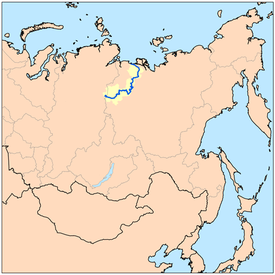- Olenyok River
-
The Olenyok River (Russian: Оленёк, sometimes spelled Olenek) is a major river in northern Siberian Russia, west of the lower Lena River and east of the Anabar River. It is 2,292 kilometres (1,424 mi) long, of which around 1,000 kilometres (620 mi) is navigable. Average water discharge is 1210 m³/s. Its major tributary is the Arga-Sala River.
The river's source is on the northern Central Siberian Plateau in Krasnoyarsk Krai, from where it flows north east through Olenyok before emptying into the Olenyok Gulf of the Laptev Sea at Ust-Olenyok just west of the Lena River delta.
The Olenyok is known for its abundant fish. It is frozen for over eight months every year and the climate in its area is harsh because of the direct influence of the Arctic.
- Dyangylakh or Dzhyangylakh (Ostrov Dyangylakh) 73°05′20″N 120°08′24″E / 73.089°N 120.140°E is a large flat delta island located ar the mouth of the Olenek River. There are many smaller islands in its immediate vicinity, like Eppet Island off its eastern side, but none comes closer to its size. Dyangylakh is 21 km long and 16 km wide.
History
In 1633 Ivan Rebrov reached the Olenyok from the Lena delta and built a fort.[1] In 1642-44 Rebrov and Fedot Alekseyev Popov reached the river but were driven out by the natives.
Pioneering Russian Arctic explorer Vasili Pronchishchev and his wife Maria Pronchishcheva died of scurvy in this area in September 1736, while mapping the coasts of the Laptev Sea. After their deaths, husband and wife were interred at the mouth of the Olenyok River.
References
- ^ Lantzeff, George V., and Richard A. Pierce (1973). Eastward to Empire: Exploration and Conquest on the Russian Open Frontier, to 1750. Montreal: McGill-Queen's University Press.
General References

This Sakha Republic location article is a stub. You can help Wikipedia by expanding it.

